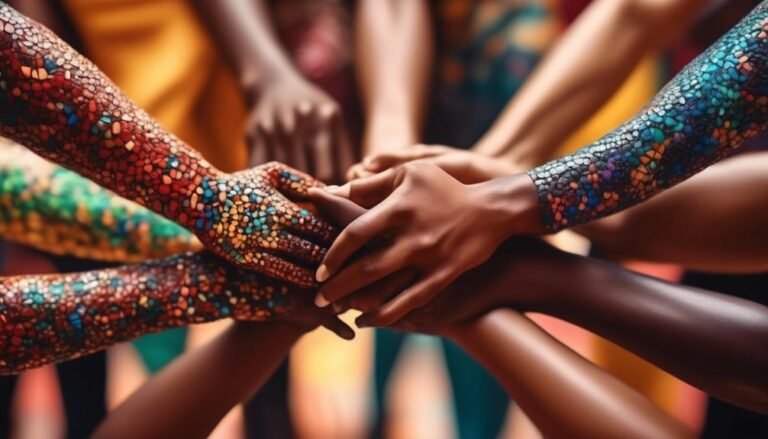Understanding and Addressing Microaggressions
Microaggressions are subtle, everyday actions or comments that communicate negative or derogatory messages towards marginalized individuals or groups. While they may seem harmless to some, these seemingly small acts can have a significant impact on individuals and communities, perpetuating stereotypes and reinforcing systemic inequalities.
In this discussion, we will explore the definition and examples of microaggressions, understand the unconscious bias behind them, and learn how to identify and recognize these subtle forms of discrimination.
Additionally, we will delve into strategies for addressing and challenging microaggressions, as well as the role of education and awareness in creating inclusive environments.
By building empathy and cultural competence, we can collectively combat microaggressions and foster a more inclusive society.
Key Takeaways
- Microaggressions are subtle expressions of bias or discrimination that can have significant negative impacts on individuals and communities.
- They affect mental health, leading to increased stress, anxiety, depression, and even PTSD.
- Microaggressions perpetuate social and cultural divisions, reinforcing stereotypes, creating barriers to inclusivity, and undermining efforts towards social change and promoting diversity.
- Addressing and challenging microaggressions requires bystander intervention, promoting allyship and solidarity, educating oneself on different cultures and experiences, implementing bystander training programs, and creating inclusive environments through diversity and inclusion training, open dialogue, and building empathy and cultural competence.
Definition and Examples of Microaggressions
Microaggressions are subtle, often unintentional expressions of bias or discrimination that can have a profound impact on marginalized individuals and communities. It is important to understand the definition and examples of microaggressions in order to recognize and address them effectively.
Microaggressions can take various forms, each reflecting a different type of bias or discrimination. One common type is microinsults, which are subtle comments or actions that convey rudeness, insensitivity, or demeaning attitudes towards a person's identity. For example, asking a person of color where they are really from implies that they are not truly American.
Another type is microinvalidations, which involve negating or dismissing a person's experiences or identity. An example of this would be telling a person with a disability that they are an inspiration for simply living their life.
Microaggressions can also be manifested through non-verbal cues, such as facial expressions or body language, that convey disrespect or disregard for a person's identity. These subtle forms of bias and discrimination can be harmful and perpetuate stereotypes, creating a hostile environment for marginalized individuals.
Impact of Microaggressions on Individuals and Communities
Microaggressions have a profound impact on individuals and communities, affecting their mental health and overall well-being. These subtle acts of discrimination can lead to increased levels of stress, anxiety, and depression, eroding the mental resilience of those targeted.
Furthermore, microaggressions perpetuate social and cultural divisions, reinforcing harmful stereotypes and creating barriers to inclusivity and equality.
It is crucial to acknowledge and address the impact of microaggressions in order to foster a more inclusive and supportive society.
Effects on Mental Health
The impact of microaggressions on individuals and communities can have significant effects on their mental health. Here are some mental health consequences and coping mechanisms related to microaggressions:
Mental Health Consequences:
- Increased stress and anxiety levels
- Feelings of depression and low self-esteem
- Development of post-traumatic stress disorder (PTSD)
- Negative impact on overall well-being and quality of life
Coping Mechanisms:
- Building a support network of trusted individuals
- Seeking professional help through therapy or counseling
- Engaging in self-care activities such as exercise, meditation, or hobbies
- Educating oneself about microaggressions and advocating for change
It is important to acknowledge and address the mental health impact of microaggressions to create a more inclusive and supportive environment for individuals and communities affected by them.
Social and Cultural Implications
The pervasive nature of microaggressions in society permeates social and cultural structures, perpetuating harm and marginalization within individuals and communities. These subtle and often unintentional acts can have profound effects on the well-being and sense of belonging of marginalized groups. Microaggressions reinforce stereotypes, create barriers to equal opportunities, and contribute to systemic inequalities. To understand the social and cultural implications of microaggressions, it is important to recognize the impact they have on individuals and communities. Microaggressions can erode trust, hinder social interactions, and create a hostile environment. They also undermine efforts towards social change and promoting diversity. By addressing microaggressions, fostering inclusive environments, and promoting awareness, we can work towards creating a society that values and embraces the diversity of its members, ultimately leading to a more equitable and harmonious world.
| Social Implications | Cultural Implications | Individual Implications |
|---|---|---|
| Reinforces stereotypes | Shapes cultural norms and values | Impacts self-esteem |
| Creates barriers to equal opportunities | Perpetuates systemic inequalities | Hinders social interactions |
| Erodes trust and fosters division | Limits cultural exchange and understanding | Undermines sense of belonging |
| Hinders social change and progress | Impacts cultural identity and pride | Contributes to mental health issues |
| Promotes exclusion and marginalization | Suppresses diverse perspectives and voices | Creates a hostile environment |
Unconscious Bias and Microaggressions
Unconscious biases, which can manifest in subtle and unintentional ways, contribute to the occurrence of microaggressions in various social settings. These biases are deeply ingrained in our minds and can influence our thoughts, behaviors, and perceptions of others without our conscious awareness.
To address the issue of unconscious bias and its connection to microaggressions, it is crucial to implement unconscious bias training programs and promote workplace diversity. Here are some key points to consider:
- Unconscious bias training: Organizations should invest in comprehensive training programs to raise awareness about unconscious biases and their impact on individuals and the workplace. This training should include education on recognizing and challenging biases, as well as strategies for creating an inclusive and equitable environment.
- Workplace diversity: Promoting diversity within the workplace can help combat unconscious biases and reduce the occurrence of microaggressions. By fostering a diverse workforce, organizations can benefit from a variety of perspectives, experiences, and talents, which can contribute to innovation, creativity, and overall success.
- Inclusive policies and practices: It is essential to establish inclusive policies and practices that encourage equal opportunities and fair treatment for all employees. This includes implementing unbiased recruitment and promotion processes, providing support for underrepresented groups, and creating a culture of respect and inclusivity.
- Ongoing evaluation and accountability: Regularly evaluate the effectiveness of unconscious bias training programs and diversity initiatives. Hold individuals and teams accountable for their actions and address any instances of microaggressions promptly and appropriately.
Identifying and Recognizing Microaggressions
Identifying and recognizing microaggressions is crucial in creating an inclusive and respectful environment. By understanding the types of microaggressions, individuals can better recognize and address these subtle forms of discrimination.
It is important to consider the impact of microaggressions on individuals, as they can contribute to feelings of marginalization and create barriers to personal and professional growth.
Additionally, analyzing microaggressions within a cultural context allows for a deeper understanding of the power dynamics and systemic biases at play.
Types of Microaggressions
When examining microaggressions, it is important to have a clear understanding of the various types that exist within our society. Differentiating microaggressions can be challenging, as they are often subtle and can be unknowingly perpetuated by individuals. Misunderstandings surrounding microaggressions can further complicate efforts to address and eliminate them.
To better grasp the concept, here are some common types of microaggressions:
- Microassaults: explicit and intentional acts of discrimination, such as racial slurs or derogatory comments.
- Microinsults: subtle, often unintentional, remarks or behaviors that convey rudeness or insensitivity, like making assumptions based on stereotypes.
- Microinvalidations: dismissing or negating a person's experiences or identity, invalidating their emotions or perspectives.
- Environmental microaggressions: when the physical or social environment perpetuates biases, such as lack of representation or exclusionary practices.
Recognizing these types of microaggressions is crucial in fostering a more inclusive and respectful society.
Impact on Individuals
To fully comprehend the impact of microaggressions, it is essential to recognize and understand how these subtle acts of discrimination can profoundly affect individuals.
Microaggressions have a significant impact on relationships and workplace dynamics. These subtle forms of discrimination can create a hostile and unwelcoming environment, leading to strained relationships between colleagues or friends. The constant exposure to microaggressions can erode trust, confidence, and self-esteem, making it challenging for individuals to feel valued or respected.
Moreover, these experiences can negatively affect an individual's mental health, leading to increased stress, anxiety, and even depression. In the workplace, microaggressions can hinder productivity, teamwork, and overall job satisfaction.
It is crucial to address and challenge microaggressions to create inclusive and supportive spaces where individuals can thrive and feel safe.
Cultural Context Analysis
Cultural context analysis plays a vital role in recognizing and understanding microaggressions. It involves examining the social, historical, and cultural factors that influence communication and behavior. By considering the cultural context, individuals can develop cultural sensitivity and improve cross-cultural communication.
Here are four key points to consider:
- Cultural norms: Different cultures have unique norms and values, which can shape individuals' perceptions and behaviors. Understanding these norms helps identify potential microaggressions.
- Stereotypes and biases: Cultural context analysis allows for the recognition of stereotypes and biases that may contribute to microaggressions. It helps individuals challenge their own preconceived notions and assumptions.
- Power dynamics: Recognizing power imbalances is essential to understanding microaggressions. Cultural context analysis helps identify how power differentials can manifest in interactions.
- Historical and social context: Examining historical and social factors helps uncover systemic issues that contribute to microaggressions. It allows individuals to address the root causes and work towards creating a more inclusive and equitable society.
Strategies for Addressing and Challenging Microaggressions
Addressing and challenging microaggressions requires a proactive approach that fosters inclusivity and cultivates a respectful and equitable environment for all individuals. It is crucial to implement strategies for bystander intervention, promoting allyship, and solidarity to effectively address these harmful behaviors.
Bystander intervention involves empowering individuals to speak out against microaggressions when they witness them. This can be done by providing bystander training programs that teach individuals how to recognize and respond to microaggressions in a constructive manner. By encouraging bystanders to take action, we create a collective responsibility for addressing and challenging these behaviors.
Promoting allyship and solidarity is another crucial strategy for addressing microaggressions. Allies can use their privilege and influence to support marginalized individuals and challenge the perpetuation of microaggressions. This can be done through active listening, educating oneself on different cultures and experiences, and actively advocating for change within their social circles and organizations.
To further assist in understanding strategies for addressing and challenging microaggressions, the following table outlines some effective approaches:
| Strategies for Addressing and Challenging Microaggressions |
|---|
| Bystander Intervention |
| Promoting Allyship and Solidarity |
| Educating oneself on different cultures and experiences |
Creating Inclusive Environments: Role of Education and Awareness
Creating inclusive environments requires a commitment to education and awareness in order to foster understanding and respect for diverse perspectives and experiences. In the workplace, promoting inclusivity and diversity through education and awareness is essential for creating an environment where everyone feels valued and respected.
To achieve this, organizations can implement the following strategies:
- Provide diversity and inclusion training: By offering educational programs that address unconscious biases, microaggressions, and the importance of inclusivity, employees can gain a better understanding of the impact of their words and actions.
- Encourage open dialogue and discussion: Creating spaces for open and honest conversations can help individuals share their experiences and perspectives, fostering empathy and understanding among colleagues.
- Establish inclusive policies and practices: Implementing policies that promote diversity and inclusivity, such as diverse hiring practices, flexible work arrangements, and accessible facilities, can create a more inclusive environment for all employees.
- Celebrate diversity: Recognize and celebrate various cultural and religious holidays, organize diversity events, and showcase diverse role models to highlight the value of different backgrounds and experiences.
Building Empathy and Cultural Competence to Combat Microaggressions
Developing empathy and cultural competence is crucial in effectively addressing and preventing microaggressions in diverse environments. One way to build empathy is through storytelling. Sharing personal experiences and narratives can help individuals understand the challenges faced by marginalized groups and foster a sense of connection and understanding. By listening to stories from different perspectives, individuals can develop empathy and gain a deeper appreciation for the experiences of others.
Promoting diversity in the workplace is another important aspect of building empathy and cultural competence. By creating an inclusive environment that values and respects individuals from different backgrounds, organizations can foster a sense of belonging and encourage open dialogue. This can be achieved through implementing diversity and inclusion initiatives, such as diversity training programs, mentorship opportunities, and employee resource groups.
Furthermore, it is essential to provide education and resources on cultural competence. This includes understanding cultural norms, traditions, and values, as well as recognizing and challenging one's own biases and stereotypes. Organizations should invest in training programs that promote cultural competence and provide individuals with the tools and knowledge needed to navigate diverse environments respectfully and effectively.
Conclusion
In conclusion, understanding and addressing microaggressions is crucial for creating inclusive environments and promoting cultural competence. By recognizing and challenging microaggressions, individuals and communities can work towards combating unconscious bias and promoting empathy.
One interesting statistic to note is that a study found that 76% of LGBTQ+ individuals reported experiencing microaggressions, highlighting the pervasive nature of these subtle forms of discrimination.
It is important for all of us to educate ourselves and actively work towards creating a more inclusive and understanding society.







